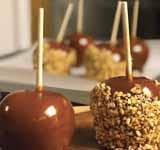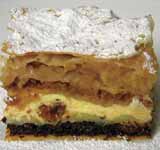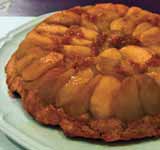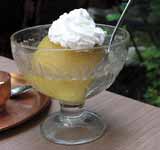1. Apple dumpling

An apple dumpling is a pie filled with apple, cinnamon, and the occasional raisin. The apples are peeled and cored, placed on a piece of dough, and filled with cinnamon and sugar. The dough is then folded over the apple and the resulting dumpling is baked until soft. The dumplings apple comes from the northeastern United States, in the region of Pennsylvania. It is a very common recipe among the Amish and is often eaten for breakfast, but they are also a very common dessert. It is also popular to eat it with ice cream or milk.
2. Apple Cider

The cider is an alcoholic beverage of low alcohol, from 2% by volume in the case of cider doux French, up to 8%, manufactured with fermented apple or pear juice. Although some authors agree that cider was known to the Hebrews, Egyptians and Greeks, this circumstance has not been documented except for the later writings of Latin authors such as Pliny the Elder (23-79 AD), who mentions drinks made with pears and apples and piris malorunque omnibus generibus, and affirms that apple wine, is the typical drink of the territory. Strabo (64 or 63 BC - AD 19 or 24), who stated that Asturians also use cider, since they have little wine, zytho etiam utuntur, vini parum habent or the Roman agronomist Palladio (4th century). There are various production processes depending on the different regional traditions. In any case, the first step always consists of collecting and choosing the different types of apple in autumn called mayar. Apples can be of many varieties but classified into three types clearly differentiated by their flavor: essential sweets to transform sugar into alcohol, acidic to maintain the natural color of the must and its cleanliness, and bitter or wild that provide tannin.
3. Apple Cobbler

The cobbler is a traditional dish in the United States and the United Kingdom, although the meaning of the term differs considerably from one country to another. In the United States, it is usually a dessert consisting of a fruit filling poured into a large baking dish over a batter that rises when cooked. The batter forms a dumpling inside the cobbler, plus a crust on top. In the UK it is usually a savory meat dish, usually a lamb casserole, covered with a scone like layer, each forming a cobbler separated. Fruit versions are also becoming more popular in the UK, although they retain the cobbler or cracker coating of the meat version, and savory versions are unknown in the US. The American variant known as Betty or Brown Betty comes from the colonial era. In 1864 it appeared in the Yale Literary Magazine with brown in lowercase, which made Betty its proper name. However, in 1890 a recipe was published in the Practical Sanitary and Economic Cooking Adapted to Persons of Moderate and Small Means with the word Brown capitalized, making Brown Betty the proper name. Brown Betties are made with breadcrumbs (or pieces of bread, or graham crackers crumbled) and fruit, usually diced apple, in alternate layers. They are cooked covered and have a consistency similar to bread pudding.
4. Apple Turnover

Apple turnover is the name for a type of pastry. The apple turnover is made of puff pastry, has a triangular shape and is filled with a mixture of apple cubes and cinnamon, possibly supplemented with almond paste, currants and/or raisins. During or immediately after baking, granulated sugar is sprinkled over the apple turnover. Quality apple turnovers are distinguished by the use of butter instead of margarine and an addition of lemon zest and a little rum flavor in the filling. The golden delicious is widely used for apple turnovers, because these apples are available all year round. The clean from Boskoop has a higher acidity and is firmer, so that taste and structure are better preserved during baking. In the Northern and Eastern Netherlands in particular, the name 'apple flap' is used for the dish that elsewhere is called apple fritter, a completely different fried apple dish.
5. Apple chips

Apple chips are chips processed by apples that are fried in a special way, usually using a vacuum fryer. If you use the normal frying method, namely using a frying pan/pan, the apples will not become chips because the fruit will be damaged by excessive heat. By using a vacuum fryer, the apples are fried at a lower temperature of about 50°-60°C so as not to damage the apples.
6. Apple crisp

The apple crisp, called apple crisp in the United States and apple crumble in the UK, is a dessert consisting of apples to the oven topped with a crispy crust. Ingredients typically include cooked apples, butter, sugar, flour, cinnamon, and often oatmeal and brown sugar, ginger, or nutmeg. Apples can be substituted for many different types of fruit, such as peaches, berries, pears, (etc). One of the most common variants is apple and rhubarb crisp., giving this one a sour contrast. Apple crisp is a relatively new invention. Of note is its absence from the first edition of the Fannie Farmer Cookbook (1896), which is a comprehensive compilation of American recipes. The first printed reference to apple crisp is from 1921, with a recipe in Everybody's Cook Book: A Comprehensive Manual of Home Cookery. The same year also appears in an article in the Appleton Post Crescent. Despite its youth, apple crisp has become an American and British tradition, especially in the fall when apples are plentiful.
7. Apple pie

Apple pie is a pie based on a simple dough and apples, possibly with additions such as currants and raisins, and is often served warm. The recipe and the type of apples used may differ per country, there is a big difference between, for example, Dutch apple pie, British apple pie and French tarte aux pommes. Two ground recipes are in circulation in the Netherlands, a recipe with short crust pastry and a, somewhat less used, recipe with cake batter. In the latter variant, the dough is not kneaded, but the flour is stirred by previously mixed soft butter, sugar and egg. The apples that are usually used are gold reins. The apple pie appeared in an English cookbook as early as 1381. The origin of the recipe is unknown. The basis of the most common recipe is a base and side of shortcrust pastry, a filling consisting of small slices of apple, currants, raisins and sometimes apricot jam, lemon juice, rum and/or cinnamon. The top is formed by a grid of dough strips. The fill is visible through the grid. Characteristic of the cake is that the filling is firm and soft at the same time. The crust dough is slightly crispy. If the latter is not the case, the apple pie is not fresh or possibly heated in the microwave.
8. Apple strudel

Apple strudel is a traditional Austrian type of pastry, which is especially popular in Vienna. Apple strudel consists of dough, apple slices and raisins. Originally it was food for poor people, but later became a culinary high-quality dish. Apple strudel is usually eaten with whipped cream, ice cream and/or warm vanilla sauce. The apple strudel is based on the dish 'baklava' and found its way from the Ottoman Empire to what was then Austria-Hungary. The pastry is therefore also popular in Hungary. It is called there almásrétes. Strudel is made from elastic, very thinly drawn dough. The apple slices are not spread over the entire dough, but only over a small strip. By rolling up the dough, various thin layers are created, which after baking are reminiscent of puff pastry. When the apple is spread over the entire surface, layers of dough will also end up between fillings after rolling up, these layers are not cooked. The traditional apple strudel is recognized by this. In Austria, this is called sucked strudel, or 'pulled strudel'. However, it is easier to make a puff pastry strudel.
9. Applesauce cake

The cake applesauce is a cake served for dessert, especially prepared from applesauce, flour and sugar, often soft texture. It is common to add several kinds of spices. When it is prepared with applesauce, it may be less chewy. Several other ingredients can go into its composition, and it is sometimes prepared and served as an accompaniment to coffee. The origins of this dessert can be traced back to the beginnings of colonial times in the United States.
10. Candy apple

The candy apples or apples caramelized are apples coated with a layer of sugar of candy. While the cover varies from place to place, they are almost always served with a toothpick in the center making them easier to eat. Caramel apples are a common delicacy at fall festivals in Western culture in the Northern Hemisphere, such as Halloween and Guy Fawkes Night, because these fall festivals fall during the annual apple harvest. Even though caramel apples and sweet apples look similar, caramel apples should not be confused with candy apples. Both are done differently. The caramel apple is made by coating an apple with a layer of sugar. The most common sugar coating is made from sugar, corn syrup, water, cinnamon, and red food coloring. The sugar syrup is created by boiling the ingredients in a saucepan. The liquid should reach about 300 degrees on a candy thermometer. Dip the apples with the sugar in the hardness stage. The sugar hardens within an hour. It can be difficult to prepare caramel apples in the summer. Humid weather prevents sugar from hardening.
11. Caramel apple

The Caramel apples are created by dipping or turning the blocks with a toothpick in candy hot, sometimes after releasing them to the market are added nuts or other candies, and allow it to cool. Alternatively, for high-volume production of sweet apples, a sheet of caramel can be wrapped around the apple, followed by heating the apple to melt the caramel evenly in it. This creates a hard candy that is easier to transport, but harder to eat. Producing sweet apples at home usually involves purchasing caramel candies for the bath, or making homemade caramel with ingredients such as brown sugar, butter, and vanilla. Homemade caramel usually results in a smoother, creamier coating. In recent years, they have become increasingly popular to decorate caramel apples for parties like Halloween. The methods used for this are the application of sugar or salt to soften the caramel, chilled by immersion, hardening the apples in white or milk chocolate, or painting finish designs on the white chocolate caramel apples with coloring. Classically, the preferred apples for use in sweet apples are tart, crisp apples like Granny Smith and Fuji apples. Softer, grainy apples can also be used, but are not preferable.
12. Medimurska gibanica

Medimurska gibanica is a traditional, savory or sweet puff pastry from several Southeast European country cuisines. It is also often prepared for festive occasions. Although the gibanica is most often made with cream cheese, there are also the rarer types with spinach, meat or potatoes and onions. Depending on your taste, the gibanica can be poured with natural yogurt. In addition to the savory versions, the gibanica is also available as a cake. A variant comes from the Croatian county of Medimurje, in which four fillings made of ground poppy seeds, cream cheese, ground walnuts and grated apples are alternately layered with puff pastry or filo pastry in a baking pan. Top it with a top layer of sour cream, eggs and/or melted butter. The word "Gibanitsa" was first mentioned in the Balkan sources of the 17th century as a name, surname or nickname. The Serbian word Gibanica was included in the Serbian Dictionary, published in 1818 by the Serbian linguist Vuk Stefanovic Karadzic. Karadzic traveled extensively in the Balkans and wrote down various interesting facts related to Serbian traditions and customs. In the dictionary, it defined gibanitsa as "a pie with soft cheese between layers of dough made with kaymak, milk and eggs".
13. Tarte Tatin

Tarte Tatin - a kind of French apple pie "inside out" in which apples are fried in butter and sugar before baking the pie. According to research, the recipe for "Tarte Tatin" was invented at the hotel of the sisters Stephanie (1838-1917) and Caroline (1847-1911) Taten in Lamotte-Bevron around the 1880s. There is a theory that during the preparation of the cake, Stephanie forgot to make a mold of dough and put the caramelized apples in a mold, and then, so as not to redo, simply covered it with dough. It is also believed that the pastry chef simply dropped the cake and then collected it as best she could. There are alternative theories that the inverted cake recipe is traditional in the Sologne region, and Stephanie only slightly modified the recipe. The sisters never called tart by their own name and did not publish cookbooks. The restaurant owner Maxim's is especially famous for the recipe. Who, having tasted the pie in Lamotte-Bevron, added it to the menu of his restaurant. Tart Taten is a specialty of the Hotel-Restaurant Taten. Tart Taten can also be made with pears, peaches, pineapple, tomatoes or vegetables such as eggplant and onions.
14. Tufahije

Tufahije is a Bosnian dessert made from apples cooked in sugar syrup with lemon juice and stuffed with walnuts, almonds or hazelnuts (sometimes in the filling is added with butter, honey, raisins, grated chocolate, cinnamon, vanilla and egg whites, rum, ground coffee). Besides Bosnia and Herzegovina, the dish is popular in Serbia, Croatia and North Macedonia, as well as among Bosnian emigrants, in particular in the United States. Tufahije is similar to Bulgarian baked apples (bulgarian apple peel), but the cooking method is different (in the Bosnian recipe, apples must be peeled beforehand and they are not baked, but boiled). However, there are also options for cooking tufachia with baking. Tufahije spread to Bosnia and Herzegovina during Ottoman rule. There is a version according to which tufachia was originally a Persian dish, which was only later adopted in the Ottoman Empire. Tufahije is usually served in wide bowls with syrup in which apples were cooked and whipped cream (sometimes garnished with cherries or currants or poured with apricot jam) and eaten with a spoon.

